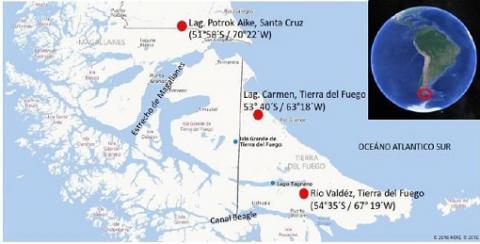P. Palermo, C. Gogorza, A. Irurzun1, M.J. Orgeira, A. Coronato, A.Sinito
2 017
Latinmag Letters, Volume 7, Special Issue (2017), MR03, 1-4. Proceedings Juriquilla, Qro, Mexico
La secuencia sedimentaria del afloramiento Río Valdéz (Isla de Tierra del Fuego, extremo Sur de Argentina) proporciona un registro continuo de variaciones paleoambientales y paleoclimáticos de alta resolución en el Pleistoceno Tardío. El método de datación por 14C tiene problemas inherentes a la metodología para utilizarlo con estos sedimentos, como la cantidad muy baja de materia orgánica contenida en los mismos y el hecho que el período cubierto este cerca del límite de edad de utilidad del método. Con la finalidad de superar este inconveniente, se utilizaron las variaciones seculares del campo magnético terrestre registradas en las secuencias sedimentarias para construir la cronología de estos sedimentos. Variaciones en inclinación y declinación se compararon con variaciones paleoseculares de los últimos 52.000 años registrados en los sedimentos de la Laguna Potrok Aike. Esta correlación hizo posible construir una escala de tiempo de alta resolución para el período 33,000 – 52,000 años A.P. para la secuencia sedimentaria del afloramiento Río Valdéz.
Palabras Claves: Variaciones Seculares, Patagonia, Magnetita
Palabras Claves: Variaciones Seculares, Patagonia, Magnetita
A sedimentary sequence from Río Valdéz outcrop (Tierra del Fuego Island, Southernmost Argentina) provides high-resolution and continuous paleoclimate and paleoenvironmental records in the Late Pleistocene. The 14C dating method has inherent inaccuracies in dating these glaciolacustrine sediments as they contain a very low amount of organic matter and the period covered by them exceeds the age limit for the method. In order to overcome this drawback, the known changes of the Earth’s magnetic field recorded in the sedimentary sequences were used to produce a more detailed and accurate timescale. The variations in the inclination and declination were compared to the paleosecular variations over the last 52,000 years recorded in the lake sediments from Laguna Potrok Aike. This correlation made it possible to construct a high-resolution time-scale for the sediments from Río Valdéz outcrop during the period 33,000 - 52,000 years B.P. This work further showed that the geomagnetic secular variations can serve as an effective tool to determine the sediments’ age and correlate the stratigraphy for the different deposition environments in a wide region.
Keywords: Paleosecular Variation, Patagonia, Magnetite
Keywords: Paleosecular Variation, Patagonia, Magnetite

